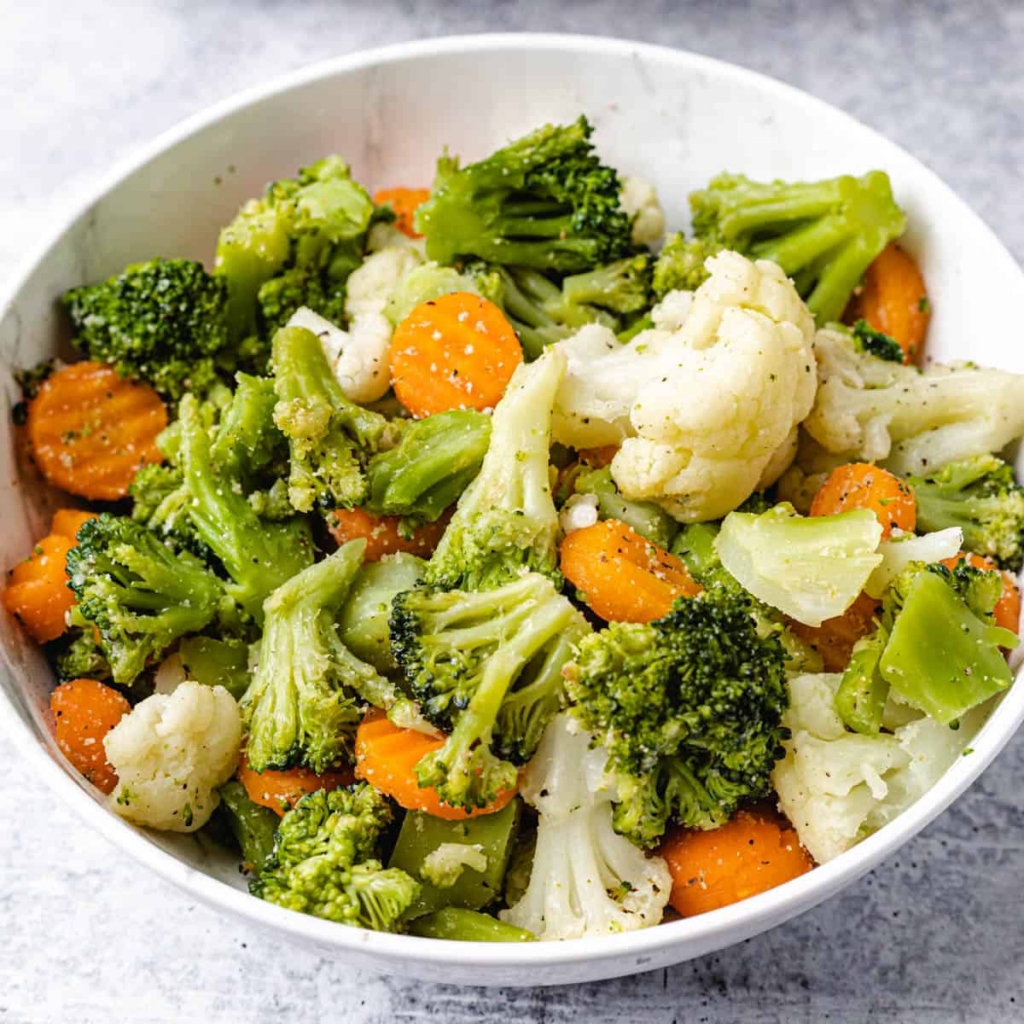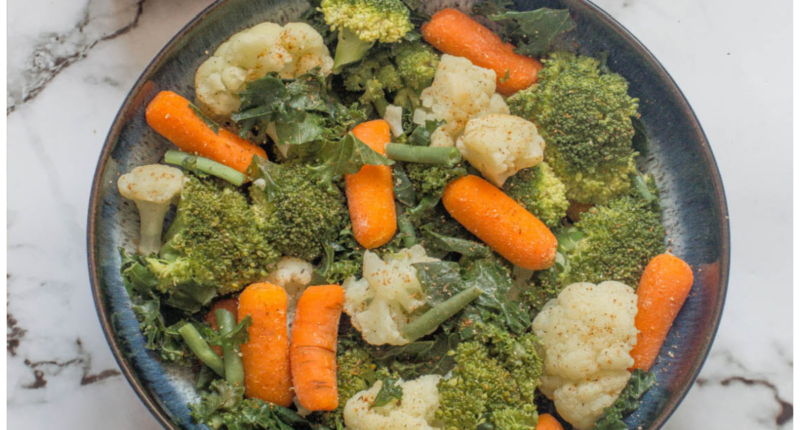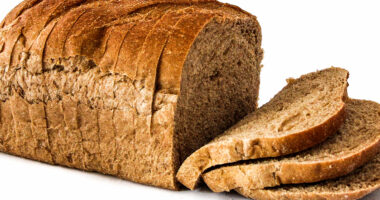How To Make Steam Vegetables Without a Steamer :- Are you looking to add more vegetables into your diet but don’t have a steamer? No problem! Steaming is one of the healthiest ways to cook vegetables as it retains their nutrients and flavor. In this blog post, we’ll show you how to make steam vegetables without a steamer. You’ll be surprised at how easy it is and how delicious your veggies will turn out. So let’s get started on this healthy culinary journey!

The Benefits of Steam Vegetables
Steaming vegetables has numerous health benefits. Firstly, it preserves the nutrients and natural flavors of the veggies. Unlike boiling or frying, steaming doesn’t involve immersing food in water or oil, which can lead to nutrient loss.
Additionally, steamed vegetables are low in calories and high in fiber content. They keep you feeling full for longer periods of time and help maintain a healthy weight.
Steaming also helps to retain the vibrant colors of vegetables such as broccoli and carrots while making them tender enough to eat without losing their crunchiness. It’s an excellent way to get children interested in eating more veggies!
Another benefit is that steaming produces less waste compared to other cooking methods since there is no need for additional fats or oils.
Adding steamed vegetables into your diet is an easy way to boost your health with minimal effort!
How to Make Steam Vegetables Without a Steamer
One of the easiest and most nutritious ways to cook vegetables is by steaming them. Steamed veggies retain essential nutrients, vitamins, and minerals that are often lost in other cooking methods. But what if you don’t have a steamer? Don’t worry; there are still plenty of options available for how to make steam vegetables without a steamer.
Firstly, fill up a pot with water and place it on your stove’s burner over high heat until boiling. Then select your vegetable of choice and chop them into small pieces or thin slices so that they can cook quickly.
Next, grab a colander or mesh strainer that fits securely inside the pot but doesn’t touch the boiling water below it. Arrange the chopped vegetables in an even layer on top of the colander or strainer before placing its lid tightly down over everything.
Let your veggies steam for 5-10 minutes depending on their thickness until they’re tender yet crisp enough to eat with some crunch left in them. Voila! You now know how to make delicious steam vegetables without having a fancy steaming machine at home!
Recipes for Delicious Steam Vegetables
There are endless possibilities when it comes to making delicious steam vegetables without a steamer. Here are some mouth-watering recipes that you can try at home:
1. Garlic and Lemon Broccoli: Start by washing and chopping broccoli into bite-sized pieces. In a pan, heat up some garlic in olive oil until lightly browned. Add the broccoli with salt and pepper to taste, cover the pan and let it cook for 5-7 minutes or until tender-crisp. Squeeze fresh lemon juice over the top before serving.
2. Soy-Ginger Asparagus: Wash asparagus spears thoroughly and trim off woody ends. Cut them into halves diagonally for easier cooking. Mix soy sauce, ginger paste, honey, sesame oil in a bowl then toss your asparagus in this marinade mixture before transferring to your pan of boiling water for about 5-10 minutes.
3. Cajun Corn on the Cob: Place corn cobs directly on simmering water seasoned with Cajun seasoning (or any spice blend of your choice). Cover the pot for around 8-12 minutes or until cooked through.
These easy-to-make steam vegetable dishes offer not only great flavor but also ample nutritional value that will guarantee satisfaction every time!

What You Need
Before we dive into how to steam vegetables without a steamer, let’s talk about what you’ll need. Fortunately, you don’t need any fancy equipment to get perfectly steamed veggies. Here are the essentials:
1. A pot with a lid: Any medium-sized pot will do as long as it has a tight-fitting lid.
2. Water: Steaming requires water, so make sure you have enough on hand.
3. A colander or mesh strainer: This will sit inside your pot and hold the vegetables above the water level.
4. Tongs or a spoon: You’ll need something to remove the hot veggies from the pot once they’re done cooking.
5. Vegetables: Of course, you can’t steam anything without some veggies! Choose your favorites and wash them thoroughly before cutting them into bite-sized pieces.
Now that you know what you need, let’s move on to how to actually steam those delicious veggies!
The Method
The method of steaming vegetables without a steamer is quite simple and easy to follow. You only need a few basic kitchen tools and ingredients to get started.
First, you’ll need a pot with a lid that can fit your colander or strainer inside. Fill the pot about 1-2 inches with water and bring it to a boil over high heat.
While waiting for the water to boil, prepare your vegetables by washing them thoroughly and cutting them into small pieces or bite-sized chunks. This will ensure even cooking and prevent any large pieces from being undercooked.
Once the water has come to a boil, place your colander or strainer inside the pot, making sure it’s sitting above the water level. Then carefully place your prepared vegetables into the colander or strainer.
Cover the pot with its lid tightly so that no steam escapes. Let it cook for around 5-10 minutes depending on how tender you like your veggies.
Remove from heat and carefully remove your cooked veggies from the colander using tongs or oven mitts as they will be hot!
With this simple method of steaming vegetables without a steamer, you can easily incorporate more healthy and nutritious foods into your diet in just minutes!

Tips and Tricks
Tips and Tricks:
1. Use a colander: If you don’t have a steamer basket, a colander can be used as an alternative. Simply place the vegetables in the colander over boiling water and cover with a lid.
2. Add seasoning: Adding some herbs or spices to your vegetables before steaming them can add extra flavor. Try adding garlic, ginger, thyme or rosemary.
3. Cut evenly: Cut your vegetables into even pieces so they will steam evenly and cook at the same rate.
4. Don’t overcook: Overcooking your vegetables will result in mushy texture and loss of nutrients. Be sure to keep an eye on them while steaming to avoid this problem.
5. Check for tenderness: Use a fork or knife to poke through the vegetable after it has been cooking for several minutes to check if it’s tender enough.
6. Experiment with different veggies: You can also try steaming different types of vegetables such as broccoli, carrots, cauliflower, green beans or asparagus.
7. Use lemon juice: Squeezing some fresh lemon juice onto your steamed veggies just before serving adds bright flavor that goes well with most dishes.
By following these tips and tricks, you’ll be able to make perfectly cooked steam veggies without using any special equipment!
Conclusion
Making steam vegetables without a steamer is easy and can be done in various ways using simple kitchen items. The benefits of this healthy cooking method are endless, from preserving the nutrients, taste, and color to keeping the calories low. With our tips and tricks for perfect steaming results every time, you can now enjoy deliciously cooked veggies as part of your everyday diet.
Experiment with different seasonings and herbs to add flavor to your steam vegetables. You can also mix them up with grains or proteins for a complete meal that’s both satisfying and nutritious. Whether you’re a beginner cook or an experienced chef looking for new ideas, these recipes will surely inspire you to eat more greens.
So why not give it a try today? Your body will thank you for it!









